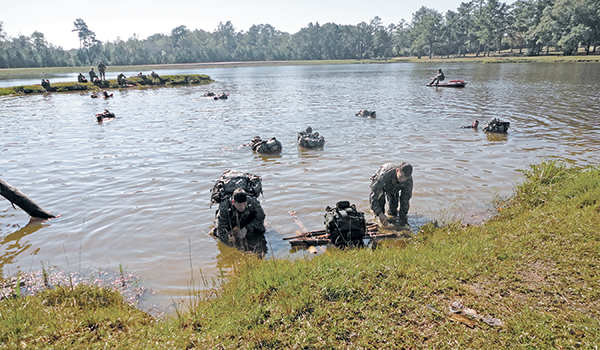
Branch Command Sergeant Major / By CSM Gregory M. Chambers: This issue of the AAAA magazine is focused on survivability, mainly how we make our aircraft more survivable in a complex combat environment, whether it’s a radar threat, an infrared threat or a countermeasure to enable our aircraft to defeat complex systems in order to deliver our combat load to its desired location.

Survival Training at South Camp, Fort Rucker, AL January 2016. / U.S. ARMY PHOTOS BY SSG BURCHAM
We have added phenomenal equipment, technology and systems to our aircraft and worked closely with industry to protect our aircraft in order to work in these complex combat environments. The resources we have used are absolutely worth every dollar spent to protect our aircraft, and our aircraft are a critical part of the maneuver force. But history has proven, at some point, our most valuable resource, the Soldiers, may find themselves on the ground in direct combat where their individual survival skills will be put to the test. Are your Soldiers ready for that environment? Individual, functional and personal survival gear are important individual skills that could be key to successful survival in a combat environment.

Water survival training at Buckhorn Lake, Fort Rucker, AL July 2016.
Individual training is probably the most critical area when it comes to survival in a combat environment, such as physical fitness, weapons training, chemical, biological, radiological, and nuclear (CBRN) training, and individual field craft training. Achieving a 290 on your annual physical fitness test (APFT) is probably not the best metric to measure your stamina for a combat environment; shooting only during the day with your dominant eye is probably not a good measure of weapons proficiency; and the gas chamber isn’t the mecca of protecting yourself in a contaminated environment. Enemy threats such as vehicles, aircraft and Air Defense Artillery (ADA) identification – can you identify the threat equipment in the area of responsibility (AOR) you are working in? AOR enemy threats, do you know who the enemy is that you are fighting against? Are these important training tasks, and does your unit have the time or “white space” on the calendar to devote to this training? As leaders we must ensure we examine every opportunity to train Soldiers, whether it’s dynamic training, static training or synthetic training. You get paid to be innovative to ensure your Soldiers are ready.
Functional Training
Functional training provides focused training skills that increase individual Soldier survivability, such as Survive Evasion Resistance Escape (SERE) level “C” training, or SERE level “A” training, Water Survival training such as drown proofing or Helicopter Overwater Survival Training (HOST), and field craft or the basic knowledge to survive with limited resources. All these functional courses are offered at the Aviation Center of Excellence. Although these courses put Soldiers in an environment that they are not familiar with or a situation that is uncomfortable, they teach extremely valuable skills that enable survivability in extreme environments. The intent of these courses is not only to train Soldiers on specific skills but to teach a Soldier what their limits are and how to overcome their limitations. These are structured courses that are taught through approved programs of instruction, but this should not limit personnel who are trained with these skills to impart their knowledge with their fellow Soldiers. This includes basic signaling, day and night land navigation, use of flares, land zone markings, basic far and near recognition signals. Again, it’s finding the time on the calendar and setting priorities when it comes to teaching these skills to our Soldiers.
Individual Survival Gear
When was the last time an instructor pilot or a nonrated crewmember (NRCM) flight instructor or a section sergeant drilled you or quizzed you on your individual survival gear, your ALSE gear, your individual CBRN equipment? Does your unit mandate where your medical kit goes on your ALSE vest so every Soldier can find it in the dark? Do all your flight rated crewmembers know how to operate individual survival radios, can they do this in the dark? Can Downed Aircraft Recovery Team (DART) crews and flight crews submit a nine-line medivac call or a nine-line call-for-fire call via your survival radio? Do your Soldiers know what is inside their aircraft survival kits and emergency kits, and are those kits placed in aircraft IAW an SOP so all unit members know where they are? Does your unit practice vehicle or aircraft extraction drills, and do your PRT sessions incorporate extraction drills? All that high tech gear is really cool if you know how to work it. Most of that gear runs on batteries. Have you trained in a non-dependent electrical environment? Do you know what equipment is electromagnetic interference (EMI) hardened, and can you operate without electricity?
Whether it’s individual, functional or individual survival equipment, a lot of the tasks or training events I outlined in this article can be done outside a scheduled training area. Leaders can use dynamic, static or synthetic training methods to train their Soldiers on individual survival. Individual survival training is probably one of the most important things we do as leaders. Make time for it. It’s important.
Above the Best!
CSM Chambers
This email address is being protected from spambots. You need JavaScript enabled to view it.
CSM Gregory M. Chambers is the command sergeant major of the Aviation Branch and the U.S. Army Aviation Center of Excellence, Fort Rucker, AL.








